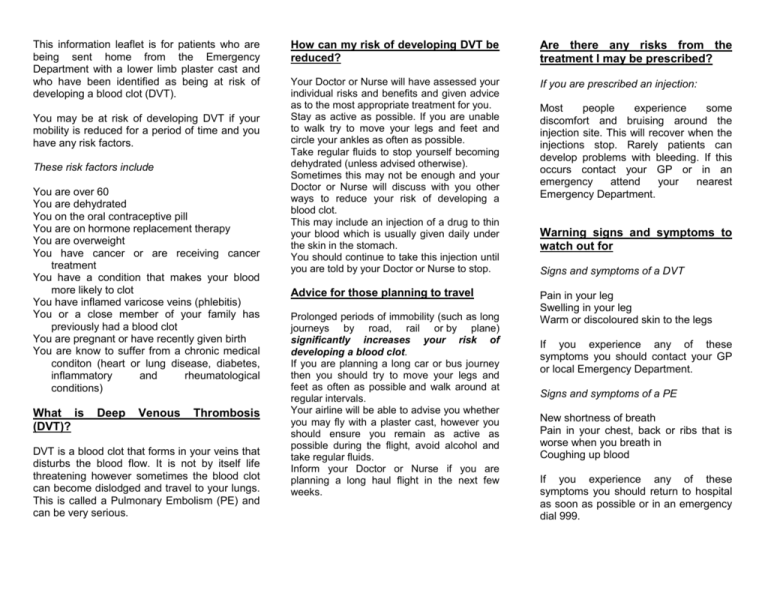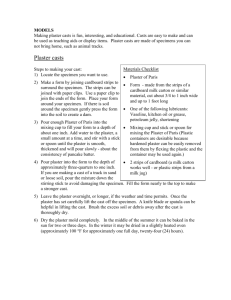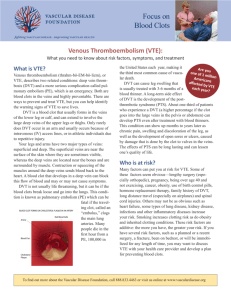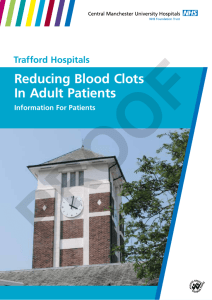View the supporting material
advertisement

This information leaflet is for patients who are being sent home from the Emergency Department with a lower limb plaster cast and who have been identified as being at risk of developing a blood clot (DVT). You may be at risk of developing DVT if your mobility is reduced for a period of time and you have any risk factors. These risk factors include You are over 60 You are dehydrated You on the oral contraceptive pill You are on hormone replacement therapy You are overweight You have cancer or are receiving cancer treatment You have a condition that makes your blood more likely to clot You have inflamed varicose veins (phlebitis) You or a close member of your family has previously had a blood clot You are pregnant or have recently given birth You are know to suffer from a chronic medical conditon (heart or lung disease, diabetes, inflammatory and rheumatological conditions) What is (DVT)? Deep Venous Thrombosis DVT is a blood clot that forms in your veins that disturbs the blood flow. It is not by itself life threatening however sometimes the blood clot can become dislodged and travel to your lungs. This is called a Pulmonary Embolism (PE) and can be very serious. How can my risk of developing DVT be reduced? Are there any risks from the treatment I may be prescribed? Your Doctor or Nurse will have assessed your individual risks and benefits and given advice as to the most appropriate treatment for you. Stay as active as possible. If you are unable to walk try to move your legs and feet and circle your ankles as often as possible. Take regular fluids to stop yourself becoming dehydrated (unless advised otherwise). Sometimes this may not be enough and your Doctor or Nurse will discuss with you other ways to reduce your risk of developing a blood clot. This may include an injection of a drug to thin your blood which is usually given daily under the skin in the stomach. You should continue to take this injection until you are told by your Doctor or Nurse to stop. If you are prescribed an injection: Advice for those planning to travel Pain in your leg Swelling in your leg Warm or discoloured skin to the legs Prolonged periods of immobility (such as long journeys by road, rail or by plane) significantly increases your risk of developing a blood clot. If you are planning a long car or bus journey then you should try to move your legs and feet as often as possible and walk around at regular intervals. Your airline will be able to advise you whether you may fly with a plaster cast, however you should ensure you remain as active as possible during the flight, avoid alcohol and take regular fluids. Inform your Doctor or Nurse if you are planning a long haul flight in the next few weeks. Most people experience some discomfort and bruising around the injection site. This will recover when the injections stop. Rarely patients can develop problems with bleeding. If this occurs contact your GP or in an emergency attend your nearest Emergency Department. Warning signs and symptoms to watch out for Signs and symptoms of a DVT If you experience any of these symptoms you should contact your GP or local Emergency Department. Signs and symptoms of a PE New shortness of breath Pain in your chest, back or ribs that is worse when you breath in Coughing up blood If you experience any of these symptoms you should return to hospital as soon as possible or in an emergency dial 999. Consent - What does this mean? Before any doctor, nurse or therapist examines or treats you they must have your consent or permission. Consent ranges from allowing a doctor to take your blood pressure (rolling up your sleeve and presenting your arm is implied consent) to signing a form saying you agree to the treatment or operation. It is important before giving permission that you understand what you are agreeing to. If you do not understand – ask. More detailed information is available on request. Information about you - The Data Protection Act 1998 Confidential records are kept about your health and the care you receive from the NHS. These records are important, helping to make sure you receive the best possible care from us. The information may also be used to plan NHS services and assist in the teaching and training of health professionals. To make sure that patient confidentiality is maintained a policy has been written informing all staff of their responsibilities. How to comment on your treatment We aim to provide the best possible service and staff will be happy to answer any questions that you have. However, if you have any concerns you can also contact the Patient Advice & Liaison Service (PALS) on 0800 917 6039 or E-mail PALS@porthosp.nhs.uk, who will be happy to talk to you. Further information NHS direct Tel 0845 4647 www.nhsdirect.nhs.uk www.nice.org.uk www.thrombosis-charity.org.uk www.dh.gov.uk DVT service Medical Assessment Unit Queen Alexandra Hospital Southwick Hill Road Cosham PO6 3LY Reducing your risk of developing a blood clot when you have a plaster cast Information for patients Tel: 023 9228 6000 (Ext 5720) Leaflet designed by: Dr Mathew Chandy (Specialty Registrar, Emergency Medicine) With advice from: Mr Simon Mullett (Consultant, Emergency Medicine) Dr Dee Fowler (Specialty Registrar, Emergency Medicine) Sister Louise Beresford (Sister, Emergency Department) Emergency Department Queen Alexandra Hospital Portsmouth Hospitals NHS Trust Cosham Portsmouth PO63LY Tel: 02392 286000 (Ext 6380) EXECUTIVE SUMMARY VTE risk assessment for patients being discharged in lower limb plaster casts: Emergency Department Audit Authors: Dr Matt Chandy (ED SpR), Dr Dee Fowler (ED SpR), Sister Louise Beresford (ED Sister and VTE Link nurse) Background NICE guidance (Guideline 92) Jan 2010: For patients being discharged with lower limb plaster cast - Consider offering low molecular weight heparin after evaluating risks v. benefits and after clinical discussion with patient. Audit Standards 100% adult patients being discharged with a lower limb plaster cast should be risk assessed for venous thromboprophylaxis. 100% of patients should be scored correctly using risk assessment proforma. 100% Patients at high risk (scoring 3 or more) should be considered for clexane prescription. 100% Patients scoring 3 or more should have documented evaluation of the risks vs benefit of prescription of clexane including relevant contraindications. 100% of patients being discharged with a lower limb POP cast should be given written information regarding reducing their risk of VTE. Methods 50 patients selected via discharge coding and identification of patients with lower limb fractures (from PACS) and identified from their notes to have been discharged from the Emergency Department with a lower limb cast. 3 data sets (50 patients in each) obtained, June – August 2010, November 2010 – January 2011, May – June 2011 Notes reviewed using AE CD view and reviewed against audit criteria. Key Results Number of patients risk assessed (n=50) Overall compliance with guideline (n=50) Summary Only a 1/3 of patients were being risk assessed when risk assessment tool was first launched. Less than 1/4 of patients were compliant with our local guidance (risk assessed correctly and discharged with written information). In our most recent compliance has improved. Now 1/2 of patients are being risk assessed and are compliant with our local guidance. Conclusion and Action points Patient information leaflet and poster (displayed prominently in treatment room) Continued education of new staff members: drop in sessions held in the ED VTE risk assessment form now included on plaster cast application form Involvement of HCSW in implementing good practice Integrate VTE awareness into plaster cast application training SIRI/RCA completed for each hospital acquired VTE (which includes patients discharged with a lower limb plaster cast from the Emergency Department.







![First Aid Training : Bronze [Power Point]](http://s2.studylib.net/store/data/005424634_1-e0b0e5e602f7c1666ebc2e9ff3f4a1b5-300x300.png)



